
Making Connections Editor: Christine Capra
Program Manager, HT Institute
2025 Fall Newsletter
Horticultural Therapy is making an impact on people’s lives.
Read more about how it’s happening.
HTI Director’s Note: More Nuggets from the New HT Textbook
By Rebecca Haller, HTM

Hi readers,
There are many learning opportunities in Horticultural Therapy Methods: Connecting People and Plants in Health Care, Human Services, and Therapeutic Programs Third Edition – just released in April this year. From that textbook let’s focus on the subject of ‘leadership styles’ for this article.‘Chapter 5, Working with Program Participants,’ describes many aspects of a horticultural therapist’s interactions with the clients they serve, including: facilitation and group leadership, therapeutic use of self, motivation and behavior management, training methods, and adaptation and modification.Since horticultural therapy is frequently carried out with groups, thoughtful and strategic choices should be made about how the horticultural therapist leads each session or gathering of clients. The therapist needs to be skilled in a full repertoire of styles to adapt to any present situation and be consistent yet also flexible and spontaneous in how they lead.Styles of leading a group include a range of directive to hands-off approaches. These are often described as autocratic/authoritarian, democratic/participative, and laissez-faire/delegative. All are applicable in horticultural therapy work, even those which may be less familiar or less of a natural fit for the personality of the therapist. Some factors that inform the amount of direction called for in practice situations include:

- intellectual, social and psychological skills and challenges of the participants
- urgency of action required, including safety concerns
- complexity of the gardening task/activity
- time allotted for a given activity
- treatment goals of participants, such as problem-solving, teamwork, etc.
- quality standards for the gardening task and resulting ‘product’
- size, composition, and social context of group
In interacting with students of horticultural therapy, I have found that many are initially averse to using the more directive leadership style of autocratic/authoritarian. They view it as stern and harsh. When used effectively and respectfully, it can be the most kind and supportive approach that considers the stresses and challenges of being a participant and allows a successful and rewarding experience and outcome for them. In some cases, it may be necessary to enable any level of participation.Therapists are encouraged to be thoughtful in their choices of leadership styles and become comfortable with the full range of approaches. Check out Chapter 5 for more ideas about working with program participants.
Happy Learning, Rebecca
Certificate Deadlines Fast Approaching!
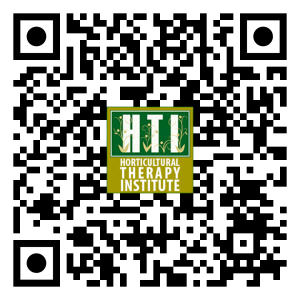
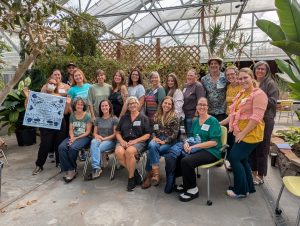
Deadlines are fast approaching to join the next cohort at the Horticultural Therapy Institute. Now is the time to take the Fundamentals of HT class and begin your journey. Learn how to combine a passion for gardening and helping people through the innovative field of horticultural therapy. At the non-profit Horticultural Therapy Institute, our mission is to provide education and training in horticultural therapy to those new to, or experienced with, the practice of using gardening and plants to improve the lives of others. The remaining three classes in the HT Certificate program in 2026 will be held in Colorado, North Carolina and Maine as well as online.
The HT Institute has provided education in the field for over 20 years and is a leader in HT education. The director, Rebecca Haller, HTM is also one of the authors and editors of both major textbooks in horticultural therapy. The format of classes meets students’ unique learning style and are offered both face-to-face and online (synchronous). All sections are the same class, simply choose one that fits your schedule. The Fundamentals of HT class cost is $950 or $760 for full-time college students. www.htinstitute.org or call 303-388-0500.
Fundamentals of HT sec. I: Oct. 15-18, 2025 (Denver, CO) Deadline: Sept. 29
Fundamentals of HT sec. II: Oct. 29-Nov. 1, 2025 (online, mountain standard time) Deadline Sept. 29
Fundamentals of HT sec. III: Nov. 12-15, 2025 (online, mountain standard time) Deadline Oct. 12
Program Profile: Craig Hospital Horticultural Therapy
Mattie Cryer, LCSW, MSW, CBIS

(Editors note: Students in the Fundamentals section I class will visit Craig Hospital) Craig Hospital is a leading neurorehabilitation and research hospital with a focus on patients who sustain a brain injury and/or a spinal cord injury. Established in 1907, Craig Hospital maintained a narrow scope of patient population but not of clinical treatment modalities and care. Craig Hospital’s investment in the diversity of rehabilitation services allowed the hospital to take place as a leader in the rehabilitation world for this patient population. In this diverse array of treatment modalities, the horticultural therapy program has deep roots with 43 years and counting. Craig’s horticultural therapy program shifted throughout the years to meet the needs of patients while continuing to grow and develop. Craig Hospital’s history with the discipline facilitated growth and understanding of what works to sustain a large program in a rehabilitation setting, positioning itself as a potential model for other facilities due to size and diversity of horticultural therapy service delivery.

The program offers 1:1 sessions for patients referred to the program, group sessions for any inpatient, drop-in gardening sessions for any member of the Craig community (staff and family members included!) on Thursday mornings, groups for caregivers, internships with community partners for grads from Craig’s programming, and more. The program runs year-round in the ‘green room’ and outdoor therapeutic garden, which has recently been constructed from the ground up as the first step in the hospital’s expansion. Through this expansion, the green room and garden are growing in size, demonstrating the hospital’s commitment to supporting the horticultural therapy program.
The horticultural therapy program benefits from the structure of the hospital – care teams emphasize teamwork and equal partnership in the rehabilitation process. Because of this mutual investment between families and the hospital, patients and families find ownership through caring for the indoor plants and garden spaces, creating something beautiful for all to enjoy. The communal effort is palpable and often piques the interests of new folks every day.
There is currently one full-time horticultural therapist. As the program continues to expand, elements are folded in to enrich the offerings of the program, such as development of a stronger volunteer base, presentations on horticultural therapy in the community, and original research. The reaches of the program continue to extend into various departments of the hospital through co-treatments and growing understanding of the benefits of horticultural therapy.

As the horticultural therapist in this position, days don’t feel like work. Working alongside people and plants (two of my favorite things) is not only healing for patients but for me, too. Horticultural therapy found me during the early days of the pandemic lockdown; the opportunity to blend nature, healing, research, and education is a gift, one I do not take for granted.
Mattie is the horticultural therapist at Craig Hospital in Englewood, CO and a graduate of the HT Institute
Tips for Practice: HT for Children with Visual Impairments
By Kelly Mitchell

(Editors Note: Anchor Center is the site of the Fundamentals of HT section I class this year) Horticultural Therapy is an extremely effective modality for children with visual impairments to make progress toward their physical, cognitive and social emotional goals. This modality comes alive at Anchor Center for Blind Children, a small nonprofit in Denver Colorado serving children aged zero to five who are blind and visually impaired and their families. Programs include preschool, infant and toddler groups, home visits, parent support and education and community programs. Gardening activities at Anchor Center incorporate a wide variety of skills and domains, targeting a variety of goals, adapted to be accessible and appropriate for children with a wide range of abilities.
Our transdisciplinary team consists of Teachers of the Visually Impaired, Early Childhood Special Educators, Physical Therapists, Occupational Therapists, Speech Language Pathologists, Music Therapists, Horticultural Therapists, Teaching Assistants and Family Support Specialists.

Anchor Center has been serving children and families in Denver since 1982 and opened the doors to the current building in 2007. Specifically designed for children with visual impairments, the building is used as a teaching tool for students who attend programs. The building’s grounds were designed to be utilized specifically for horticultural therapy (HT). Children can explore the sensory garden, smell plants in the herb beds, and pick a tasty vegetable to eat with their lunch in the vegetable gardens. All children who participate in center-based programs receive HT, and the horticultural therapist is a member of the therapy team, setting, programming for and monitoring progress on individual and group goals for participants.
The visual system is intricate and complex, visual impairments can be caused by issues in the structures of the eye, the nerves that transmit visual information to the brain, or the areas of the brain that process visual information. The range of visual impairments is broad, and so too must be the range of tools and strategies to support individuals to access their environment most effectively.
The Expanded Core Curriculum
Most of the early learning in children with typically developing vision occurs through incidental learning. This is learning that occurs just by observing what happens in their surroundings, for example watching mom turn on the lights, watching big brother play with a toy, or watching a ball roll away when it is dropped. Children with visual impairment need to be intentionally taught concepts which are not being acquired through incidental learning. The Expanded Core Curriculum was developed to intentionally teach children these concepts and skills. This curriculum is divided into nine domains:
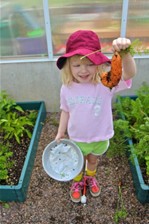
- Sensory Efficiency
- Compensatory Skills
- Self-Determination
- Orientation and Mobility
- Social Interaction
- Independent Living
- Assistive Technology
- Recreation and Leisure
- Career Education
At Anchor Center, the Expanded Core Curriculum is embedded into our education both for students and caregivers, as well as our assessments and goal setting.
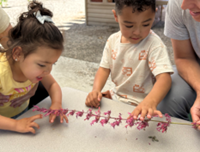
With any child, it is important to establish a relationship of trust and mutual respect to maximize learning. This is particularly important for children with visual impairments as they are more dependent on adults to ensure their safety and help them process and understand the world around them. It is essential when working with a child with visual impairment to take time to establish rapport. Getting to know these children well is also essential to determine the level of support they need while still providing opportunities for growth, the best way to present visual materials, and what motivates them. Understanding the way a child learns allows the therapist to create a space and programming where the child can thrive and maximize progress toward their goals.
A common goal for all students who attend Anchor Center is to reach their highest potential for independence. We want our students to be active participants in their world, not passive recipients. It is important to foster and build skills for independence starting at a young age so that children are confident to explore, engage, and excel in their lives. It is also extremely important to develop each child’s sense of autonomy and right to refuse physical contact. Some strategies we teach parents, caregivers, and other professionals working with students with visual impairments to help build independence include:
- Feet first: It is important for children with visual impairments to be comfortable tactilely exploring a variety of materials and develop tactile discrimination skills, which they will use to identify and utilize objects in their environment, and for some children these skills are necessary to read Braille. Children with visual impairments need to be experiencing and exploring tactilely at every opportunity. However, especially very young children who are not yet able to engage in these experiences independently, it is important that they are introduced appropriately. It is common for children with visual impairments to be tactilely defensive and unwilling to touch unfamiliar or unpreferred textures (i.e. sticky, squishy, wet, cold). One way to introduce an unfamiliar or unpreferred texture is to take off a child’s shoes and socks and allow their feet to experience the texture first.
- Hand-under-hand: It is important to respect and preserve the autonomy of children with visual impairments. This is especially important for their hands, which will be especially important for their independence throughout their lives. When working with children with visual impairments, best practice is to never grab or manipulate a child’s hands to help them engage in an activity. We teach parents, caregivers and other professionals to utilize hand under hand where a child places their hand on top of an adult’s and are able to feel how the adult is moving their hand to explore or play. The child can choose to touch and engage with the material or activity themselves, or they can choose to pull their hands back at any time. This both allows the child to engage with what the adult is presenting to them and preserves their autonomy.
- Wait Time: When you give a child a prompt, it is important to give them an appropriate amount of time to process what you are asking them to do, process how they are going to do it, and physically do it. Especially for novel tasks, it is important to provide a clear prompt in a manner you know the child can understand and remain still and quiet as you wait for their response. Wait time can vary from 2 – 60 seconds depending on the child. After you give a prompt, wait remaining still and quiet, before you repeat the prompt or offer a higher level of prompting
- Narration: There is a lot of information that a child with visual impairment is not receiving about their environment, it is the responsibility of the adult to narrate the appropriate and relevant information. Based on the child’s needs in the moment and the environment, the adult should decide what and how much information should be narrated based on the individual child. Some children want to know everything about their surroundings and what is going on around them, and others will tune the narrator out if more information is being provided than they are able to process. Information should be prioritized in order of safety, orientation and mobility, information relevant to the current activity and instructions, information about peers, and then additional information about the surroundings that is not necessarily relevant to the task. For example, if a child is walking across the garden, it would be much more important to tell them there is a low hanging branch in the path where they are walking than describing a flower that they are walking past.
- Avoiding Learned Helplessness: visual impairments create a barrier for children to access their immediate environment. When adults, with the very best of intentions, do things for the child without involving the child in the process, it inhibits learning. For example, if a child finishes watering a plant and throws their watering can on the floor, a teacher can easily pick it up and put it back in its place without involving the child. However, when the child finds the same watering can in its place at the beginning of the next activity, it would be reasonable for the child to assume they can return the watering can to where they found it by simply throwing it. It is often much quicker and easier for adults to do many of these small pieces of routines, but especially for children with visual impairments, it is important to involve them in every step of the routine, whether that involves simply narrating what you are doing as you pick up and put away the watering can, or providing appropriate orientation and mobility instruction for the child to pick it up themselves and put it away, involving children in every step of their routines teaches them the independent living skills they will need to successfully complete everyday tasks.
Activities to Target Goals

Goals that are set for students at Anchor Center are based on each child’s individual needs and learning style and can be very diverse. It is important to plan activities intentionally to ensure that goals are being addressed and monitored. Gardening activities incorporate a wide variety of skills and domains, so they can target a wide variety of goals, and can be adapted to be accessible and appropriate for children with a wide range of abilities. Here are a few examples of activities and goal areas that these activities can be used to address:
- Children can add soil to garden beds, mix soil in a potting tidy, scoop into buckets, carry to the garden bed and spread around the bed. This task can address goals targeting a wide variety of gross motor skills, working together with peers, tolerating unpreferred textures, orientation and mobility, tool use, and spatial awareness.
- Children can pull leaves off flowers and glue them on to paper to create a card for a friend or family member. This can address goals targeting a wide variety of fine motor skills, color identification, tactile discrimination, grasp strength, one-to-one correspondence, counting, spatial awareness, social relationships, and literacy.
- Children can pick a pumpkin from the garden, scoop seeds out of the pumpkin and follow a recipe to bake the seeds to make a snack. This activity can address goals targeting orientation and mobility, functional lifting, tolerating unpreferred textures, tactile discrimination, tool use, counting, literacy, and trying unfamiliar foods.
Helpful Tools
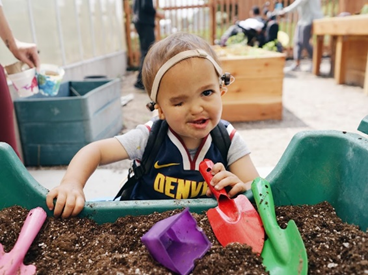
- Spray bottles are great for watering and help children develop finger strength and finger isolation, which are important for reading and writing in both braille and print
- A sponge can be used as a watering tool for children with limited finger dexterity
- Potting Tidys help children to organize materials and provide a boundary that can be very helpful for children with visual impairments to provide spacial awareness
- Baking sheets are useful for tabletop activities and can be used to create a boundary for each child’s materials for the task
- Magnifying glasses can be very helpful for children with low vision to see the smaller details of plants and materials they are working with
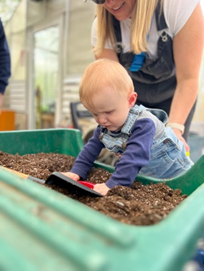
Horticultural Therapy is an extremely effective modality for children with visual impairments to make progress toward their physical, cognitive and social emotional goals. Involvement in horticultural therapy activities has the additional benefits of engaging curiosity and problem-solving skills and fostering a lifelong love of nature and the outdoors. Children are also able to be outside and engage with natural materials, which provide numerous health benefits including strengthening the immune system and regulating the sympathetic nervous system. Overall, engaging children with visual impairments in Horticultural Therapy helps to cultivate healthy, happy children!
Kelly Mitchell is the horticultural therapy program coordinator at Anchor Center and a graduate of the HT Institute
HTI Kudos
New AHTA Board Members
Four HTI graduates have been elected to the American Horticultural Therapy Association board of directors for the term beginning in October 2025. Congratulations to: Amy Fee Bruzzichesi, MSW, HTR; Brooke Moren, CTRS, HTR; Danielle Stojan, HTR, Meghan McKiernan, BS, HTR
Students Receive Credentials
Congratulations to the following HTI students who recently gained credentialing through the American Horticultural Therapy Association: Danielle Stojan, HTR; Brooke Moren, HTR; Karin Bailey, HTR; Tara Hoit, THP; Susan Morgan, THP; Carol Hunter, THP; Alexandra Schmidt, THP; Wendy Battaglia, THP; Diana Sette, THP. We are proud of your dedication to the field.
Busy Fall for HTI Director
HTI director, Rebecca Haller, HTM has a busy fall teaching four of our horticultural therapy classes and speaking online to audiences around the world. With two sections, each of Horticultural Therapy Management and Fundamentals of Horticultural Therapy, she hopes to inspire students who are finishing training to launch successful and enduring programs, and those beginning training to find their ‘place’ in the profession. Presentations include a discussion of HT education at an international healing garden symposium by Jardin Santé in Paris, the keynote talk for the annual conference of the Canadian Horticultural Therapy Association, a behind the scenes look at the third edition of Horticultural Therapy Methods for Trellis (the Scottish Therapeutic Gardening Network), and an info session about the Institute at the annual conference of the American Horticultural Therapy Association.






